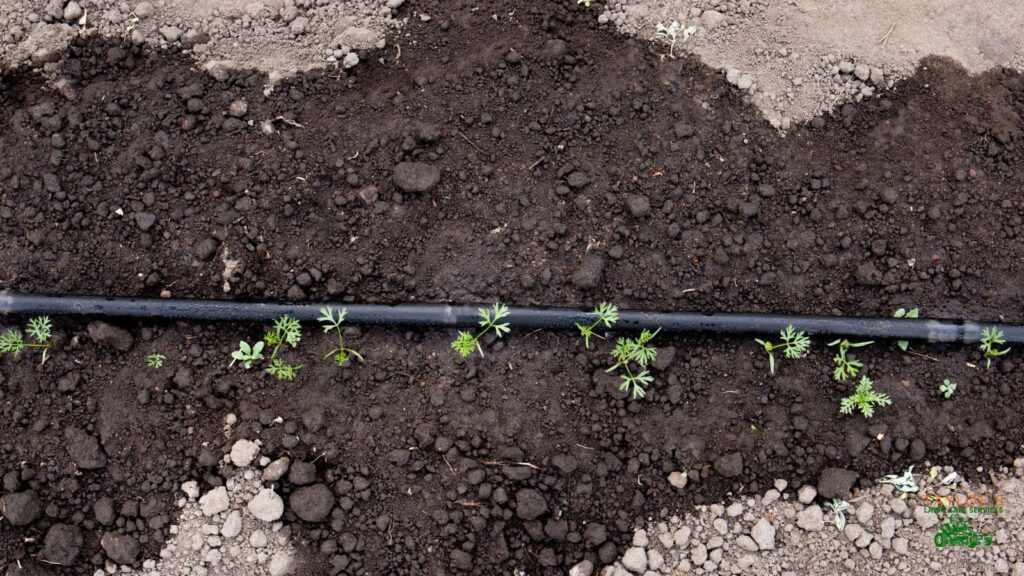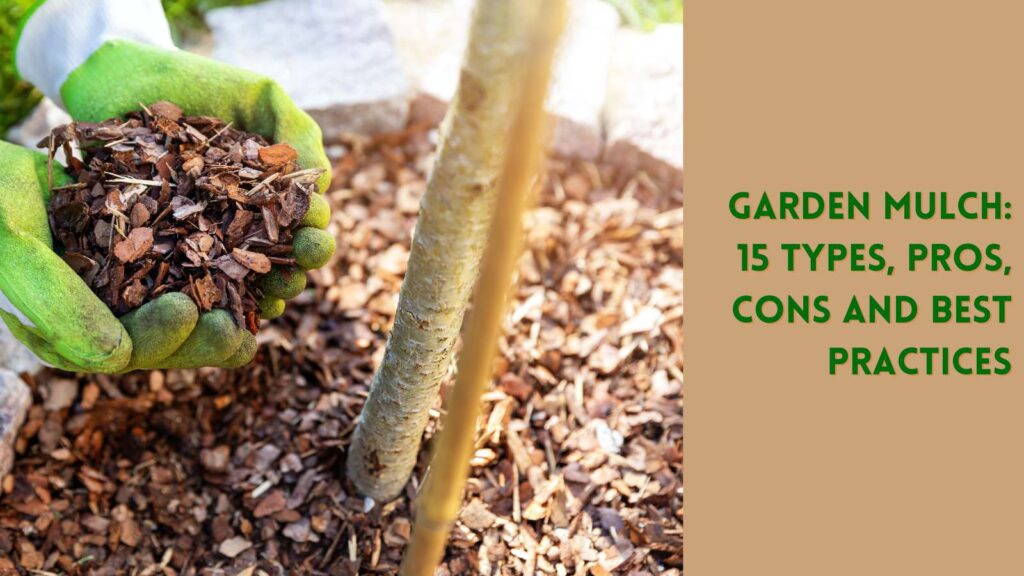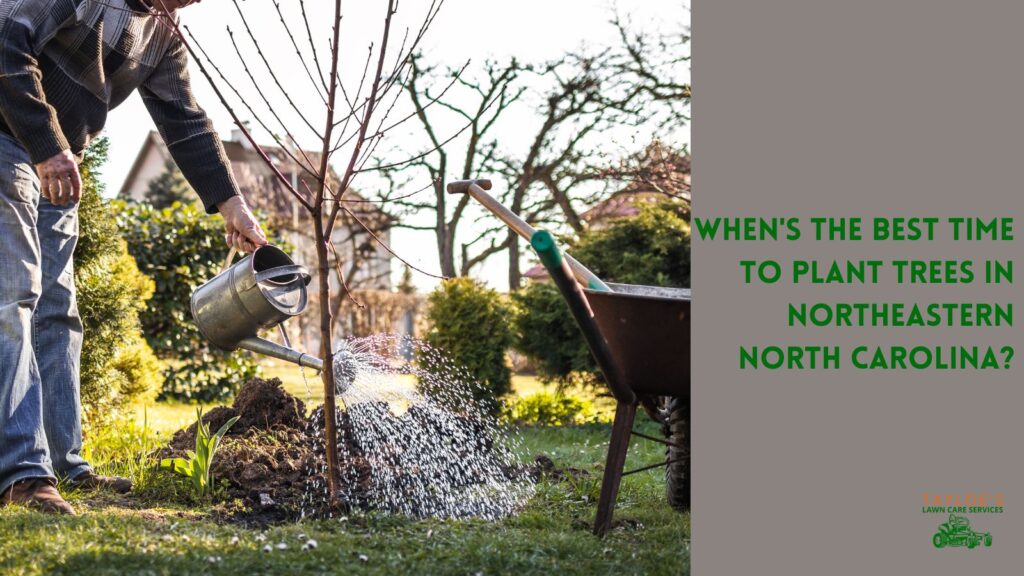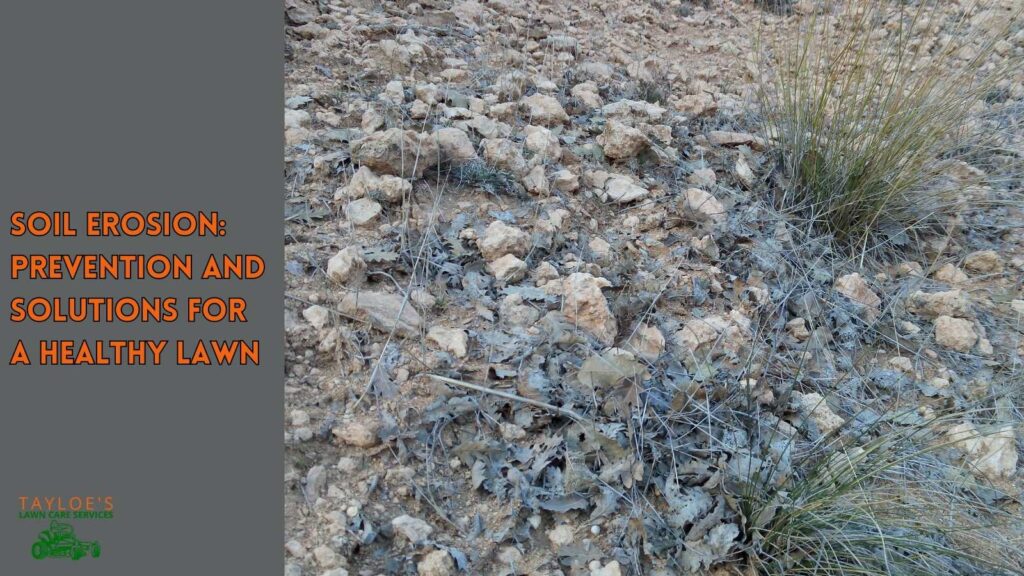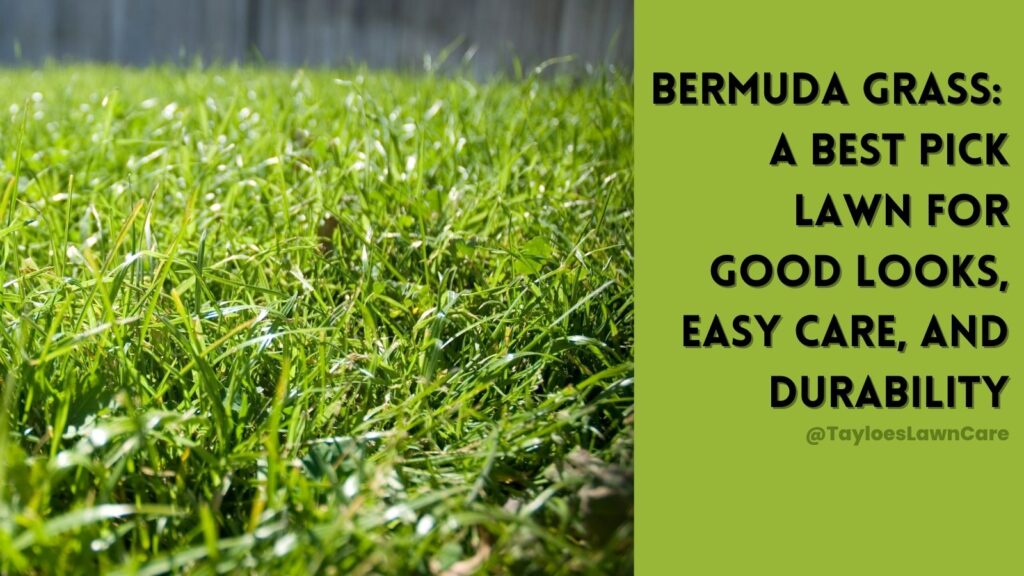Last Updated on: 12th December 2025, 12:47 pm
Keep the soil temperature cooler without overwatering.
Controlling the soil moisture content in your lawn and garden is a key to healthy plant growth. The challenge intensifies during the hot summer months as rising temperatures can lead to faster evaporation and increased plant water demands. Moisture levels are also a key factor impacting soil temperature.
This article will explore practical and sustainable strategies to maintain optimal soil moisture, keeping your landscape lush and vibrant without excessive watering. From selecting the right mulch to implementing efficient irrigation techniques, learn how to protect your soil’s moisture balance and promote a healthier ecosystem in your backyard.
How Soil Moisture Content Helps Maintain Healthy Soil Temperatures
Soil moisture plays a crucial role in regulating soil temperature. Wetter soils stay cooler than dry soils under the same environmental conditions because water absorbs and retains heat more efficiently than dry soil components. This section delves into the science behind this phenomenon and why maintaining the right moisture levels is essential for soil health.
Benefits of Maintaining Optimal Soil Moisture
Optimal soil moisture is important for several reasons beyond just temperature regulation. It supports nutrient uptake by maintaining a solvent environment where nutrients can dissolve and become accessible to plant roots. Additionally, adequate moisture is crucial for the survival of soil microorganisms that contribute to plant health and soil structure. Maintaining consistent moisture levels also helps prevent the soil from becoming waterlogged or excessively dry. Either of those issues can lead to plant stress and poor growth.
Monitoring Soil Moisture Levels
Monitoring soil moisture can be done through several methods that suit different needs and budgets. The simplest is the feel and appearance method, which involves physically touching the soil to assess its moisture content. Soil moisture sensors can be used to measure more precisely. These devices provide real-time data and can help in making informed watering decisions. Installing a weather station that measures precipitation and evaporation rates for those managing larger landscapes can also be beneficial.
Watering Practices to Optimize Soil Temperature
Effective watering practices are crucial for maintaining the ideal soil moisture and temperature balance, essential for healthy plant growth and water conservation. Understanding and implementing the right watering techniques can significantly influence how well your garden thrives during the warmer months.
Timing Your Watering
Watering early in the morning is the most effective strategy to optimize water usage and control soil temperature, says NC State University. This practice takes advantage of the cooler temperatures and less intense sunlight in the morning, significantly reducing the evaporation rate. When water is applied at this time, it has a better chance of soaking deeply into the soil, reaching the roots where it is most needed, and providing the right amount of water throughout the day as weather conditions change.
Benefits of Drip Irrigation
Drip irrigation is a highly efficient watering method that offers numerous benefits over traditional overhead watering systems. By delivering water directly to the soil at the base of the plant, drip irrigation reduces wastage that typically occurs from evaporation and runoff associated with sprinkler systems. This method allows for precise water application, ensuring that plants receive the exact total water they need directly at their roots.
The localized, targeted approach of drip irrigation conserves water and keeps the soil moisture more consistent. This can be particularly beneficial in regulating soil temperature, as wet soil will generally remain cooler than dry soil under the same environmental conditions. Since the water is delivered directly to the root zone and not sprayed over the entire area, it minimizes the wetting of plant leaves and surrounding areas, which further helps reduce water loss.
Alternatives to Drip Irrigation
While drip irrigation is highly effective, there are other methods to consider for those who may not be able to implement it. Soaker hoses, for example, offer a similar benefit by slowly seeping water along their length and directly into the soil. This method promotes deep water penetration and minimal evaporation, making it another suitable option for maintaining optimal soil moisture and temperature.
Remote-Sensing Technology
Advancements in remote-sensing technology have revolutionized how gardeners manage irrigation and soil temperature. These technologies can provide real-time data on soil water levels and temperature and cater to plants’ specific watering frequency needs.
With sensors, users can receive updates directly to their smartphones or computers. This data allows for precise irrigation scheduling based on actual soil conditions rather than estimates. This ensures optimal watering, prevents over-irrigation, and maintains ideal soil moisture and temperature, promoting healthier plant growth and enhanced water conservation.
Choosing the Right Mulch for Soil Temperature and Moisture Control
Mulching is an indispensable tool in the gardener’s arsenal for controlling soil temperature and moisture levels. It serves multiple functions: moderating soil temperature, conserving moisture, and enhancing soil health. Each material type has benefits and is suitable for different gardening needs.
Types of Organic Mulch
Organic mulches perform the essential functions of moderating soil temperature, conserving moisture, and contributing to the soil’s overall health; acting as natural fertilizers. Here are some common organic mulches:
Straw: Lightweight and easy to spread, pine straw is particularly effective at insulating soil, which helps keep the temperature stable. It’s ideal for vegetable gardens and around fruit-bearing plants as it also provides a clean barrier against soil-borne diseases.
Bark Chips: In various sizes, bark chips are a popular choice for ornamental plants and pathways. They decompose more slowly than organic mulches, providing a long-lasting barrier against moisture loss and temperature extremes.
Shredded Leaves: Often readily available in the fall, shredded leaves can protect delicate vegetation during the winter months. In the growing season, they help maintain moist and cool soil conditions.
Benefits of Mulching
Applying a two to three-inch layer of mulching material around plants has several benefits:
Temperature Control: Mulching stabilizes temperature fluctuations by insulating the soil. During hot days, mulches keep the soil cooler; during cool nights, it helps retain the day’s warmth, providing a stable environment that benefits root development and plant health.
Moisture Conservation: Mulching reduces water evaporation from the soil, thereby maintaining a more consistent moisture level. This is particularly beneficial during drought or in areas with water usage restrictions.
Weed Suppression: A total amount of 2″ will inhibit the growth of weeds by blocking sunlight from reaching the soil surface, reducing the need for frequent weeding.
Soil Health Improvement: As organic mulches decompose, they add valuable organic matter to the soil. This improves soil structure, enhances nutrient availability, and even improves the soil’s ability to absorb and retain available water.
Considerations for Application
While mulching provides numerous benefits, proper application is crucial:
Avoid Making Volcanoes: When applying it around trees, avoid piling it against the trunk, a practice often called “mulch volcanoes.” This can lead to moisture buildup around the trunk, encouraging rot and other diseases.
Renew Regularly: Organic mulches decompose over time and need to be replenished. Check the depth of your materials regularly and add more as needed to maintain the recommended two- to three-inch layer.
Choose Types Based on Need: When choosing your mulching materials, consider your plants’ specific needs and the soil type. Some types, like cedar bark, may offer additional benefits such as pest repellence, which can be a deciding factor depending on your needs.
By carefully selecting the right type and applying it correctly, gardeners can significantly enhance soil moisture retention, stabilize soil temperatures, suppress weed growth, and improve their gardens’ overall health and appearance.
Moisture Soil Temperate Impacts Newly Planted Trees and Seeds
Soil moisture content plays an important role in the survival and health of newly planted trees and seeds, particularly in agriculture. Young plants are especially vulnerable to environmental stresses, and the moisture content of the soil can significantly influence their development and survival.
Impact on Germination and Root Development
Seeds need the soil’s initial moisture level to initiate the biochemical processes that lead to sprouting. Unsaturated soil can fail to provide the water content required for germination. Seeds need consistent contact with moist soil to initiate this process. Inadequate soil moisture can delay or completely inhibit germination, jeopardizing the establishment of crops or new plantings.
Root Growth in Young Trees
The condition of the soil at the root level, particularly near the soil surface, is vital for root establishment in saplings and younger trees. Young roots primarily explore just below the soil surface. If the soil dries out too quickly due to high soil temperatures or the roots absorb too little water, the delicate new roots can be damaged, leading to poor plant growth and increased vulnerability to disease and wilt.
Influence of Soil Moisture on Soil Temperature
Maintaining adequate soil moisture is essential for moderating soil temperatures. In areas of bare soil, temperatures can fluctuate widely, which is detrimental to most plants, particularly young ones that do not yet have extensive root systems to access deeper, more stable moisture reserves. By ensuring the soil is consistently damp, you help to buffer these temperature extremes, creating a more favorable environment for ongoing plant growth.
Soil Temperatures and Germination
Soil temperature is a critical factor in seed germination. It influences the speed at which seeds germinate and the overall success rate of germination. Different plant species require different temperature ranges for optimal germination, making it essential to understand and manage bare soil temperatures effectively.
But what are the optimal soil temperatures?
Each type of seed has a specific temperature range that promotes the best germination. For example, cool-season vegetables like lettuce and spinach germinate best at lower temperatures, typically between 40°F and 60°F (4°C to 15°C). On the other hand, warm-season favorites like tomatoes and peppers prefer soil temperatures between 70°F and 90°F (21°C to 32°C). Exceeding or falling below these soil temperatures can significantly delay germination. Conversely, it can help reduce germination rates.
Selecting the Right Location and Soil Management Practices
Choosing the right location for planting is also critical. Areas that naturally retain moisture without becoming waterlogged are ideal. This involves understanding the landscape and microclimate of the planting area, including how sunlight, shade, and natural drainage patterns affect moisture availability. Additionally, organic materials can improve soil moisture retention and overall health, supporting robust plant development. Mulches can further assist in maintaining soil moisture and temperature, providing a protective layer that minimizes moisture loss and temperature variability.
By considering these factors, gardeners and farmers can significantly enhance the survival rate and health of just-planted trees and vegetation, ensuring successful germination and growth in their agricultural endeavors.
The Impact of Soil Conditions on Plant Health and Water Efficiency
The relationship between soil conditions and plant health cannot be overstated. Over the past several decades, research has consistently shown how soil quality, moisture content, and temperature directly affect plant vitality and water use efficiency.
Enhancing Water Availability and Plant Absorption and Maximizing Available Water
Well-balanced soil moisture content ensures that water is sufficiently available to plants, preventing stress and supporting optimal growth. Properly hydrated soil allows roots to more effectively absorb water and nutrients, which are critical for the health and development of leaves and the overall vitality of the plant. In contrast, soil that is too wet or dry can limit these essential resources’ availability, potentially stunting plant growth or leading to other health issues.
Reducing Water Runoff
Correctly managed soils can absorb and retain water more efficiently, reducing runoff. This is crucial, especially during precipitation, as it ensures more water penetrates the ground and reaches plant roots instead of being lost as the water moves across the surface. Effective use of soaker hoses, for example, can provide slow, steady irrigation that promotes deeper water infiltration and minimizes surface runoff. That helps control the nutrients and water available to the vegetation.
Stabilizing Soil Temperature: The Role of Moisture in Temperature Control
Soil moisture content plays a crucial role in moderating soil temperature. Adequate moisture often means that soil temperatures are more stable, preventing extreme temperature fluctuations that can harm plant health. Measured amounts of water can help maintain the thermal capacity of the soil, keeping it cooler during hot days and warmer during cold nights, which aids in protecting vegetation against temperature stress.
Optimizing Plant Growth and Health: Direct Benefits to Plant Structure
The impact of well-managed soil extends to the physical structure of plants. Roots in well-maintained soil have better growth conditions, leading to stronger, healthier plants that can withstand environmental stresses and diseases. Additionally, plant foliage benefits from the stable conditions of good soil management, leading to greener, more robust growth.
Property owners can significantly enhance plant health, increase water efficiency, and ensure the sustainability of their landscapes and crops by strategically managing soil conditions- particularly focusing on maintaining optimal soil moisture and temperature. This comprehensive approach to soil health underscores soil conditions’ critical impact on the broader ecosystem.
Still Struggling With Regulating Soil Temperatures? Put Heat-Sensitive Plants in Garden Beds with Afternoon Shade
For gardeners looking to cultivate heat-sensitive plants, understanding the importance of strategic planting in areas that provide afternoon shade is crucial. These plants typically require protection from the harsh afternoon sun, which can significantly elevate soil and air temperatures, leading to stress and potential damage.
Identifying Heat-Sensitive Plants
Heat-sensitive plants typically thrive in cooler temperatures or are prone to wilting and sunburn under intense sunlight. Examples include many agricultural crop varieties of lettuce, spinach, or other leafy greens. Add ornamental plants like impatiens and ferns to that list. These plants benefit from cooler conditions, especially during the hottest part of the day.
Benefits of Afternoon Shade
Afternoon shade can provide a respite for these plants during the peak heat hours. By situating heat-sensitive vegetation in areas where they will be shaded in the afternoon, gardeners can:
Reduce Plant Stress: Shielding plants from intense afternoon sun helps prevent stress responses such as leaf scorch, wilt, and halted growth.
Lower Soil Temperature: Shade helps maintain cooler soil temperatures, which is critical for the health of heat-sensitive plants. Cooler soil encourages better root growth and water uptake, which plays an important role in overall plant health.
Conserve Water: Shaded areas typically retain moisture longer than areas exposed to full sunshine, reducing the need for frequent watering and enhancing water efficiency.
Designing and Maintaining a Garden for Optimal Shade
To effectively incorporate afternoon shade into your garden design, consider the following strategies:
Use Existing Structures: Buildings, fences, and taller trees can naturally provide the necessary shade. Plant heat-sensitive plants on the east side of these structures to ensure they are shaded during the hotter, later parts of the day.
Plant Tall Plants Strategically: Tall plants or shrubs can cast shadows on smaller, more delicate plants. For example, planting sunflowers or corn in front of lower-growing, shade-preferable plants can provide natural, mobile shade throughout the day.
Create Temporary Shade: Consider using shade cloths or planting climbing vines on trellises for gardens lacking natural shade. These can be placed to shield plants during the afternoon and adjusted as the sun’s path changes with the seasons.
Maintaining a garden with heat-sensitive plants in shaded areas also involves:
Monitoring Moisture Levels: Ensure the soil doesn’t stay too damp, especially after being irrigated or post-precipitation. Use mulch to help stabilize moisture levels and prevent overwatering.
Checking for Pests and Diseases: Shaded, cooler areas might attract specific pests or become breeding grounds for fungal diseases. Regularly inspect vegetation for signs of disease or infestation and treat appropriately to prevent spread.
By thoughtfully planning and maintaining afternoon shade areas, gardeners can successfully grow various heat-sensitive species, even in warmer climates.
Related Reading:
The Takeaway: Soil Temperatures and Soil Moisture Are Closely Related…and Key to a Healthy Lawn and Garden
Living in northeastern NC means dealing with hot sunny days and little summer rainfall, then it’s important to understand the connection between soil moisture and soil temperatures. Bare soil in the hot sun makes for a hot root zone, which can kill sensitive grass and plant species.
Author Profile

- Deborah Tayloe is the CEO and co-founder of Tayloe's Lawn Care Services, LLC. She has a B.S.Ed and holds certificates in soil and water management and herbology from accredited programs.
Latest entries
 GardeningSeptember 27, 2025What perennials, shrubs, and trees don’t like fall pruning (and why)?
GardeningSeptember 27, 2025What perennials, shrubs, and trees don’t like fall pruning (and why)? Trees and ShrubsSeptember 14, 2025Fall Shrub Pruning Guide (September–October)
Trees and ShrubsSeptember 14, 2025Fall Shrub Pruning Guide (September–October) Trees and ShrubsApril 22, 2025Boxwood Blight: Early identification and isolation
Trees and ShrubsApril 22, 2025Boxwood Blight: Early identification and isolation Flower GardenApril 8, 2025John F. Kennedy Rose: Hybrid tea rose with elegant white blooms
Flower GardenApril 8, 2025John F. Kennedy Rose: Hybrid tea rose with elegant white blooms

